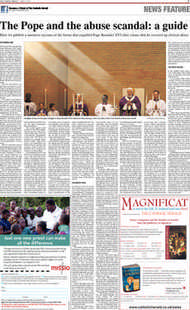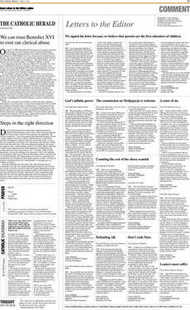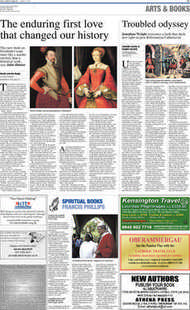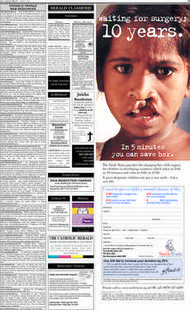Page 5, 9th April 2010
Page 5
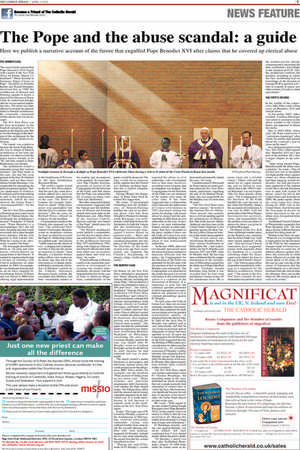
Report an error
Noticed an error on this page?If you've noticed an error in this article please click here to report it.
Tags
Share
Related articles
Priests Must Be Shepherds To Their Flock, Says Pontiff
America Gives Pope A Rapturous Welcome
Taxpayers' Money Should Not Be Used To Demonise The Pope
Cardinal Tells Pope: The Church Is With You
This Is A Stormy Pontificate But Also A Productive One
The Pope and the abuse scandal: a guide
THE MUNICH CASE
The recent furore surrounding Pope Benedict XVI began with a report in the New York Times on Friday, March 12, headlined “Abuse Scandal in Germany Edges Closer to Pope”. The article, by Nicholas Kulish and Rachel Donadio, disclosed that in 1980 the Archdiocese of Munich and Freising agreed to house a priest of the Diocese of Essen while he underwent therapy after he was accused of molesting boys. The priest was later allowed to resume his pastoral duties in Munich archdiocese. He eventually committed further abuses and was prosecuted.
The New York Times was the first newspaper in the English-speaking world to report on the Munich case. But it was first brought to the attention of the archdiocese by the German paper Süddeutsche eitung .
The report was explosive because the future Pope Benedict was in charge of Munich archdiocese at the time the decision was taken to send the priest, known initially as Fr “H” and later named as Peter Hullermann, for therapy.
The archdiocese issued a statement saying that “serious mistakes” had been made in the case, but that the vicar general at the time, Fr Gerhard Gruber, and not then Archbishop Joseph Ratzinger, was responsible for reassigning the priest to pastoral ministry. Vatican spokesman Fr Federico Lombardi said he had nothing to add to the archdiocese’s statement, which he said showed the future Pope’s “non-responsibility” for the errors.
The New York Times quoted a Dominican priest and canon lawyer, Fr Thomas Doyle, who challenged the archdiocese’s account. “Nonsense,” Fr Doyle said. “Pope Benedict is a micromanager. He’s the old style. Anything like that would necessarily have been brought to his attention. Tell the vicar general to find a better line. What he’s trying to do, obviously, is protect the Pope.” The newspaper described Fr Doyle as “an early and wellknown whistle-blower on sexual abuse in the Church”. It omitted to mention that he had a history of clashing with Church authorities on other matters. In 2004, for example, he was dismissed from his post as an air force chaplain by Archbishop Edwin O’Brien and was barred in 2008 from offering legal representation in the Archdiocese of St Louis by the then Archbishop Raymond Burke.
The world’s media seized on the New York Times report. And the next day some news outlets offered new, and even more dramatic, interpretations of the case. The Times of London, for example, headlined its report “Pope knew priest was paedophile but allowed him to continue with ministry”. But the story, by Richard Owen, offered no evidence for the headline.
Commentators hostile to the Church also pounced on the case. The celebrated New Atheist Christopher Hitchens wrote an incendiary column for Slate in which he accused the Pope of “obstructing justice on a global scale” and said his “whole career has the stench of evil – a clinging and systematic evil that is beyond the power of exorcism to dispel”. Sean Murphy, a Canadian former police officer who worked on an abuse case that led to the conviction of a Catholic priest, published a systematic refutation of Hitchens’s article on the Catholic Education Resource Centre website. He concluded that Hitchens had been “remarkably careless in his reading and incompetent in his research”. In a rare interview Mgr Charles Scicluna, promoter of justice of the Congregation for the Doctrine of the Faith, said that claims that the Pope was responsible for covering up abuse were “false and calumnious”.
But other respected Catholic commentators suggested that the Vatican and the Archdiocese of Munich and Freising should shed more light on the Hullermann case. John Allen of the National Catholic Reporter said that “true friends of the Pope” should press for full disclosure.
“The Munich archdiocese could publish a comprehensive list of every priest, diocesan and religious, who served in the archdiocese between May 1977 and February 1982, along with whatever information Church officials had at the time about any accusations against them, and what was done,” he wrote.
“Church officials in Munich could invite responsible journalists or investigators to examine the records independently, obviously with the understanding that in the case of false or unproven allegations, confidentiality of the parties would be preserved. The idea would be to reassure public opinion that the Church isn’t holding anything back, that this is indeed complete transparency.” George Weigel, the biographer of Pope John Paul II, echoed this suggestion.
He wrote: “A documented chronology how the Archdiocese of Munich-Freising handled the case of an abusing priest who had been brought to Munich for therapy while Ratzinger was archbishop would help buttress the flat denials, by both the Vatican and the archdiocese, that Ratzinger knowingly reassigned a known abuser to pastoral work ... More and clearer explanations of how the canonical procedures put into place at the Congregation for the Doctrine of the Faith several years ago have accelerated, not impeded, the Church’s disciplining of abusive clergy would also be useful.”
THE MURPHY CASE
On March 24, the New York Times published a sensational new report alleging that top Vatican officials, including the future Pope, “did not defrock a priest who molested as many as 200 deaf boys”. The article, headlined “Vatican Declined to Defrock US Priest Who Abused Boys” and written by Laurie Goodstein, claimed that internal correspondence from bishops directly to Cardinal Ratzinger, published on the paper’s website, showed “that while Church officials tussled over whether the priest should be dismissed, their highest priority was protecting the Church from scandal”. The paper said that the cardinal had failed to respond to two letters from Archbishop Rembert Weakland of Milwaukee concerning the priest, Fr Lawrence Murphy, and that the case was halted after Fr Murphy wrote to Cardinal Ratzinger saying he should not be tried because he had repented and was in poor health.
The report created a media firestorm as newspapers and television stations across the world picked up on the allegations. BBC News online, for example, ran the headline “Pope accused of failing to act on sex abuse case”. Many websites and television programmes held discussions over whether the Pope should resign. The Vatican press office took the unusual step of issuing a detailed statement on an individual case. It is worth reproducing in full because it exposes some of the weaknesses of the New York Times report.
It said: “The tragic case of Fr Lawrence Murphy, a priest of the Archdiocese of Milwaukee, involved particularly vulnerable victims who suffered terribly from what he did. By sexually abusing children who were hearingimpaired, Fr Murphy violated the law and, more importantly, the sacred trust that his victims had placed in him.
“During the mid-1970s, some of Fr Murphy’s victims reported his abuse to civil authorities, who investigated him at that time; however, according to news reports, that investigation was dropped. The Congregation for the Doctrine of the Faith was not informed of the matter until some 20 years later. It has been suggested that a relationship exists between the application of Crimen sollicitationis [a 1922 document setting out norms for dealing with sexual abuse by clergy] and the nonreporting of child abuse to civil authorities in this case. In fact, there is no such relationship. Indeed, contrary to some statements that have circulated in the press, neither Crimen nor the Code of Canon Law ever prohibited the reporting of child abuse to law enforcement authorities.
“In the late 1990s, after over two decades had passed since the abuse had been reported to diocesan officials and the police, the Congregation for the Doctrine of the Faith was presented for the first time with the question of how to treat the Murphy case canonically. The Congregation was informed of the matter because it involved solicitation in the confessional, which is a violation of the Sacrament of Penance. It is important to note that the canonical question presented to the Congregation was unrelated to any potential civil or criminal proceedings against Fr Murphy.
“In such cases, the Code of Canon Law does not envision automatic penalties, but recommends that a judgment be made not excluding even the greatest ecclesiastical penalty of dismissal from the clerical state. In light of the facts that Fr Murphy was elderly and in very poor health, and that he was living in seclusion and no allegations of abuse had been reported in over 20 years, the Congregation for the Doctrine of the Faith suggested that the Archbishop of Milwaukee give consideration to addressing the situation by, for example, restricting Fr Murphy’s public ministry and requiring that Fr Murphy accept full responsibility for the gravity of his acts. Fr Murphy died approximately four months later, without further incident.” The New York Times report was further undermined when Fr Thomas Brundage, the presiding judge in the case, published an article revealing that not a single journalist had attempted to contact him to verify the facts. His testimony was significant because he said that, to the best of his knowledge, the future Pope played no part in the case.
He wrote: “With regard to the role of then Cardinal Joseph Ratzinger (now Pope Benedict XVI), in this matter, I have no reason to believe that he was involved at all. Placing this matter at his doorstep is a huge leap of logic and information.” Fr Brundage initially said the case against Murphy was never halted, but later confirmed that it was abated shortly before the priest’s death.
“Fr Murphy’s death two days after Archbishop Weakland’s August 19 1998 letter made the matter moot as de facto death permanently abated the case,” he wrote.
Canadian priest Fr Raymond de Souza raised yet more questions about the New York Times report, particularly regarding the role of Archbishop Weakland, who was responsible for the Murphy case for more than 20 years.
“The New York Times story had two sources,” he wrote in the National Review Online. “First, lawyers who currently have a civil suit pending against the Archdiocese of Milwaukee. One of the lawyers, Jeffrey Anderson, also has cases in the United States Supreme Court pending against the Holy See. He has a direct financial interest in the matter being reported.
“The second source was Archbishop Rembert Weakland, retired Archbishop of Milwaukee. He ... had responsibility for the Fr Murphy case between 1977 and 1998, when Fr Murphy died. He has long been embittered that his maladministration of the Archdiocese of Milwaukee earned him the disfavour of Pope John Paul II and Cardinal Joseph Ratzinger, long before it was revealed that he had used parishioners’ money to pay off his clandestine lover. He is prima facie not a reliable source.” Others criticised the report for its vague chronology and its failure to state clearly that in the 1990s Cardinal Ratzinger was not responsible for most priestly abuse cases. The Congregation for the Doctrine of the Faith handled the case because of the claim that Murphy abused the sacrament of Confession. It was only in 2001, with the publication of the Motu Proprio Sacramentorum sanctitatis tutela, that responsibility for the problem of sexual abuse of minors by clerics was given to Cardinal Ratzinger.
On March 24 the New York Times published another report on the Munich case, claiming that the future Pope was “kept more closely apprised” of the case “than previous Church statements have suggested, raising fresh questions about his handling of a scandal unfolding under his direct supervision before he rose to the top of the Church’s hierarchy”. The Vatican press office responded immediately, referring to a statement by the Munich archdiocese which said: “‘The article in the New York Times contains no new information beyond that which the archdiocese has already communicated concerning the then archbishop’s knowledge of the situation of Fr H. Thus the archdiocese confirms the position, according to which the then archbishop had no knowledge of the decision to reassign Fr H to pastoral activities in a parish. It rejects any other version of events as mere speculation.”
THE POPE’S RECORD
In the middle of the controversy John Allen wrote a long essay on Benedict XVI and clerical abuse.
In November 2002, Allen recalled, Cardinal Ratzinger was asked to comment on the abuse scandal in the United States and appeared to blame the media.
But in 2003-2004, Allen said, the Pope underwent a “conversion experience” after which “he and his staff seemed driven by a convert’s zeal to clean up the mess”.
In a subsequent article in the New York Times Allen argued that “Benedict XVI isn’t just part of the problem. He’s also a major chapter in the solution.” “After being elected Pope, Benedict made the abuse cases a priority,” he wrote. “One of his first acts was to discipline two high-profile clerics against whom sex abuse allegations had been hanging around for decades, but had previously been protected at the highest levels. He is also the first pope ever to meet with victims of abuse, which he did in the United States and Australia in 2008. He spoke openly about the crisis some five times during his 2008 visit to the United States. And he became the first pope to devote an entire document to the sex abuse crisis, his pastoral letter to Ireland.” Archbishop Vincent Nichols of Westminster suggested that Pope Benedict was “the one above all else in Rome that has tackled this thing head-on”.
Writing in the Times he said: “When he was in charge of the Congregation for the Doctrine of the Faith he led important changes made in Church law: the inclusion in canon law of internet offences against children, the extension of child abuse offences to include the sexual abuse of all under 18, the case by case waiving of the statue of limitation and the establishment of a fast-track dismissal from the clerical state for offenders. He is not an idle observer. His actions speak as well as his words.”
blog comments powered by Disqus






